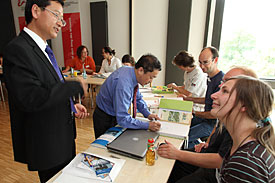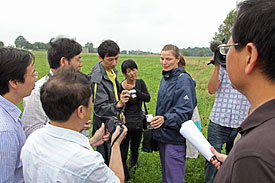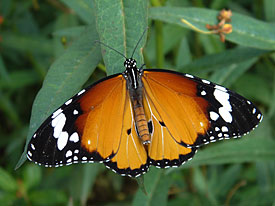Press release from August 14th, 2009
German butterfly experts export know-how
Now butterflies are also being counted in China, Australia and Israel.
Leipzig/Peking/Canberra/Tel Aviv. In future, butterflies in the People’s Republic of China are likely to be monitored using European monitoring methods. Ecologists from several Chinese research institutions and the Helmholtz Centre for Environmental Research (UFZ) laid the foundations for this cooperation on Friday. Experts from China, Germany, Australia and Israel met in Leipzig from 10 to 14 August to share their experiences in butterfly conservation and to intensify already existing research cooperations. The Workshop formed part of the German Chinese Year of Science and Education 2009/10 organised by the Federal Ministry of Research and Education (BMBF).

Ecologists from several Chinese research institutions and the Helmholtz Centre for Environmental
Research (UFZ) laid the foundations for this cooperation on Friday. Experts from China, Germany, Australia and Israel met
in Leipzig from 10 to 14 August to share their experiences in butterfly conservation and to intensify already
existing research cooperations. The Workshop formed part of the German Chinese Year of Science and Education
2009/10 organised by the Federal Ministry of Research and Education (BMBF).
Photo: Klaus-Dieter Sonntag/ fotoplusdesign.de

Excursion to habitats of Large Blue Butterflies (Maculinea nausithous and teleius) near
Altenburg, South of Leipzig. The butterfly’s survival depends on a large number of factors - as it belongs to the genus Maculinea.
This means that it is dependent not only on a specific food plant for the caterpillars, but also on a particular species of
ant. The caterpillars trick the ants into carrying them into their nest where they feed on the ants’ brood through the winter.
However, this trick works only on one very specific type of ant.
Photo: Klaus-Dieter Sonntag/ fotoplusdesign.de

The Plain Tiger (Danaus chrysippus) is a common butterfly which is widespread in Asia and
Africa. It is believed to be one of the first butterflies to be used in arts, as it is possibly shown on a 3500 year old Egyptian
fresco in Luxor.
Photo: Prof. Dr. Yalin Zhang/ Chinese Butterfly Society
Know-how developed at the UFZ is already being applied in Australia and Israel, where monitoring networks are being set up. In Germany the UFZ set up the Butterfly Monitoring Scheme five years ago together with the German Society for the Conservation of Butterflies and Moths (GfS). Since then, more than 500 volunteers have been counting and recording butterflies with a standardised method all over the country, providing the researchers with important data on distributions and trends of butterfly populations as well as information on land use and climate change in order to assess their impacts on these insects. Butterfly monitoring originated in Britain, where butterflies have been counted since 1976. The idea has since spread to many other European countries. Activities throughout Europe are coordinated by the umbrella organisation "Butterfly Conservation Europe (BCE)". Scientists from the UFZ were among those who established the BCE.
As butterflies are excellent indicators of the ecological condition of most terrestrial habitats, the Helmholtz Centre for Environmental Research has been working with them for many years in the context of its biodiversity research focus. Butterflies play a central role in a large number of international projects and have enabled major advances to be made in the protection of species diversity in science and practice. Butterfly monitoring in Germany was a core theme at the first German-Chinese workshop on butterflies and moths last week. Based on the experience gained by the UFZ, the possibility of setting up similar systems in selected regions in China was discussed. On a series of excursions the Chinese scientists were shown projects set up to protect endangered Large Blue butterflies and were given practical field demonstrations of the monitoring methods. The daily workshop activities have been described in reports and images in a dedicated blog in which the BMBF and UFZ introduce the people behind this initiative and attempt to portray the unique atmosphere of the workshop (www.dcjwb.net/de/index.php; www.dcjwb.net/300.php).
Since 1978 there are close links between Germany and China in the fields of Science and Technology. Today, german-chinese research teams jointly participate in many international projects. In recent years bilateral universities and research institutions have been founded. To emphasis the significant role of german-chinese cooperations in education and research, the "German-Chinese Year of Science and Education 2009/2010" was initiated jointly by the German minister of education and research, Prof. Dr. Annette Schavan, the Chinese minister of science and technology, Prof. Dr. Wan Gang, and the Chinese minister of education, Prof. Dr. Zhou Ji. The UFZ-Workshop was part of this programme funded by BMBF.
However, Europe and, soon, China are not the only places where volunteers are being brought in to assist scientists with counting butterflies. In Australia a team of more than 50 people from universities, nature conservation authorities and environmental organisations has got together to collect data on a species of butterfly which faces extinction. The team members systematically searched for the Golden Sun Moth (Synemon plana) in the Australian summer from September to April. This diurnal moth is critically endangered, as its habitat - the natural temperate grassland has shrunk to less than five per cent of its original size in recent decades. The larvae of the moth is thought to feed exclusively on Wallaby grass, an original grass species that has declined dramatically since the introduction of sheep farming by European settlers and urban expansion in Australia. This pilot project was presented at the German-Chinese workshop by Anett Richter from the Institute for Applied Ecology at the University of Canberra and the UFZ. Ms Richter is coordinating the research in Australia and is currently writing her PhD on the impact of native grassland fragmentation on insect biodiversity in Australia.
Dr. Guy Pe’er of the Helmholtz Centre for Environmental Research (UFZ) has been publicising the idea in his home country, Israel. As insects have not been protected before in Israel, the protection of 14 species of rare butterflies on 30 April 2009 has been a major coup. The Israeli Lepidopterologists’ Society hopes that this step will broaden public awareness of the protection of butterflies and consequently boost participation in the planned butterfly monitoring scheme. The monitoring scheme is particularly important for studying the impacts of climate change both on butterflies and on fauna general. This is because Israel encompasses a sharp climatic gradient - with average rainfall ranging from over 1000 mm in the north to less than 30 mm in the south - and thus it serves as a major source of migratory butterflies and seasonal range-shifts in response to climatic triggers. Additionally, with the East African Rift Valley crossing Israel, it is an important migratory route not only for birds but also for a variety of butterflies. The monitoring scheme therefore will have importance not only for nature conservation in Israel but also potentially worldwide for identifying links between range-shifts, migrations, and climate. Guy Pe'er also gave a talk on his work at the German-Chinese workshop.
Further information:
about Butterfly Monitoring Scheme in Germany:
Elisabeth Kühn, Josef Settele, Reinart Feldmann
Helmholtz Centre for Environmental Research (UFZ)
Phone +49-345-558-5263
www.ufz.de/index.php?en=10387
www.ufz.de/index.php?en=817
tagfalter-monitoring@ufz.de
about "Sun Moth Count" in Australia:
Anett Richter (de+en), Will Osborne (en)
Institute for Applied Ecology, University of Canberra, ACT 2601, Australia
Phone: +61-2-620-2937, +61-2-620-5377
www.ufz.de/index.php?de=10285
http://aerg.canberra.edu.au/php/showstudent.php?usercode=richter
http://aerg.canberra.edu.au/teams/osborne
about Butterfly Monitoring Scheme in Israel:
Dr. Guy Pe'er (de+en+il)
Phone +49-341-235-1715
www.ufz.de/index.php?de=15885
biodiversity-group.huji.ac.il/members/Guy.html
www.dw-world.de/dw/article/0,,3830727,00.html
about Butterfly Monitoring Scheme in China:
Dr. Xiushan Li (de+en+cn)
Phone: +49-345-558-5222
or
Helmholtz Centre for Environmental Research (UFZ)
Press office
Tilo Arnhold
Phone: +49 341 235 1269
presse@ufz.de
Further links
German-Chinese Workshop on the Future of Butterflies and Moths:
www.blog.dcjwb.net
Butterfly Monitoring Scheme in Germany:
www.tagfalter-monitoring.de
online-Community for nature observation:
www.science4you.org
"Sun Moth Count" in Canberra/Australia:
aerg.canberra.edu.au/teams/osborne/moth-count
Golden Sun Moth (Synemon plana):
www.environment.gov.au/cgi-bin/sprat/public/publicspecies.pl?taxon_id=25234
The Butterflies and Moths of Israel:
www.nature-of-oz.com/butterflies.htm
The Israeli Lepidopterists Society:
www.geocities.com/RainForest/1153/index.html
At the Helmholtz Centre for Environmental Research (UFZ) scientists research the causes and consequences of far-reaching environmental changes. They study water resources, biological diversity, the consequences of climate change and adaptation possibilities, environmental and biotechnologies, bio energy, the behaviour of chemicals in the environment and their effect on health, as well as modelling and social science issues. Their guiding research principle is supporting the sustainable use of natural resources and helping to secure these basic requirements of life over the long term under the influence of global change. The UFZ employs 930 people at its sites in Leipzig, Halle and Magdeburg. It is funded by the German government and by the states of Saxony and Saxony-Anhalt.
The Helmholtz Association helps solve major, pressing challenges facing society, science and the economy with top scientific achievements in six research areas: Energy, Earth and Environment, Health, Key Technologies, Structure of Matter, Transport and Space. With 28,000 employees in 15 research centres and an annual budget of around EUR 2.4 billion, the Helmholtz Association is Germany’s largest scientific organisation. Its work follows in the tradition of the great natural scientist Hermann von Helmholtz (1821-1894).
